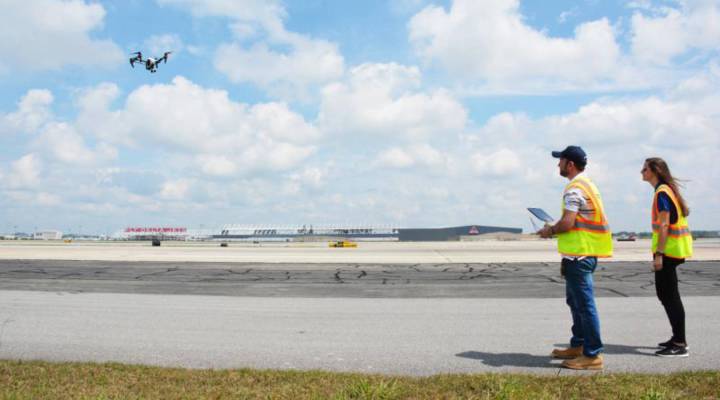
How an Atlanta airport is using drones to help with runway maintenance
How an Atlanta airport is using drones to help with runway maintenance

It’s just before noon on a sunny Friday morning, and air traffic controllers are in a bit of a rush to get planes airborne. One by one, jetliners fire up their engines and roar down runway 27R at Hartsfield-Jackson International Airport in Atlanta. The airport’s longest runway is about to close to all traffic for maintenance.
Well, almost all traffic.
The whir of propellers sends a small, white drone into the heat haze above the runway, kicking off the second unmanned aircraft flight in a month at Hartsfield-Jackson.
Federal regulations now allow drones in the congested airspace around major hubs like Los Angeles International Airport and LaGuardia Airport but only with the Federal Aviation Administration’s permission. In Atlanta, drones are helping make maintenance operations more efficient.
After hovering for a moment, the drone zipped back and forth across the pavement snapping pictures. Those will become computer models of the runway, which is slated for repairs.
“This will allow us to 3-D map the runway and be able to see detailed cracks and be able to plan better for replacing the runways,” said Chaim Van Prooyen, who is overseeing the project for Hartsfield-Jackson.

A photo of runway 27R captured by drone. It’s one of many engineers at Atlanta’s airport will use as they plan repairs to the runway, which is crucial to Hartsfield-Jackson’s operations.
Normally, this work happens on foot. Teams armed with cameras walk the runways to assess wear and tear. That process can take up to five hours. Van Prooyen said a drone can finish in half that time, which has a big up side.
“Keeping our runways open longer,” he explained. “The more that we can have our airfield open for aircraft to land and take off, the more efficient that we can be and less impactful for the airspace.”
And that means fewer delays for passengers.
On the side of the runway, Katie Eleam stood watching the drone intently, acting as a spotter for the flight.
“You’re drifting to the right a bit!” she called to her partner flying the drone.
Eleam is an aviation planner for Michael Baker International, the company working with Hartsfield-Jackson on the project. It’s her job to make sure nothing interfers with the drone’s flight.
“The airfield is so controlled that I’m not worried about other aircraft being in our area, so it’s more about the wildlife,” she said. Her team used a drone from Chinese manufacturer DJI. You can buy one for just a few thousand dollars.
Jim Duguay served as the pilot for the day’s flight.
“It’s a little intimidating at the world’s busiest airport, for sure,” he said. “But air traffic control has done a good job of moving all the traffic away, and it’s a good, bright day to capture data.”

Katie Eleam acts as a spotter for pilot Jim Duguay, who has to fly the drone manually in the busy airspace around Hartsfield-Jackson Atlanta International Airport.
All this is relatively new. The Federal Aviation Administration recently approved drone use in the airspace around major U.S. airports.
Jim Williams said that makes the Atlanta drone flight a pretty big deal. He works with unmanned aircraft for the consulting firm Dentons.
“I think that going forward you’ll see more of that as the FAA gets more comfortable with controlled drone operations in and around airports,” he said.
Tim Canoll is president of the Air Line Pilots Association and flies for Delta Air Lines. He said he welcomes more drones at airports.
“This is the expansion of new technology to help our economy,” he said. “So, overall it’s a good thing.”
| Why we need anti-drone technology |
| How soon will it be a drone world? |
| Drones to help with Indiana search and rescue efforts |
Canoll said drones will be better at spotting problems with runways and that will make flying safer. And their efficiency will mean more time in the sky for his pilots.
“Now that’s all said with the caveat that it has to be done in a safe manner,” Canoll explained. “The FAA has worked hard to put mitigations in place for these commercial operations that make them safe.”
Still, Canoll said it might take airline passengers time to adapt.
And inside Hartsfield-Jackson’s south terminal, traveler Gail Walton said she’d be pretty concerned if she looked out of her airplane window and saw a drone.
“I would probably wonder what it was doing out there; probably ring my call bell and ask one of the flight attendants what it was,” she said.
It’s a question flight crews will likely hear more in the future. The FAA has already OK’d more than 500 commercial drone operations around the country’s busiest airports.
There’s a lot happening in the world. Through it all, Marketplace is here for you.
You rely on Marketplace to break down the world’s events and tell you how it affects you in a fact-based, approachable way. We rely on your financial support to keep making that possible.
Your donation today powers the independent journalism that you rely on. For just $5/month, you can help sustain Marketplace so we can keep reporting on the things that matter to you.


















